Last updated on April 19, 2024
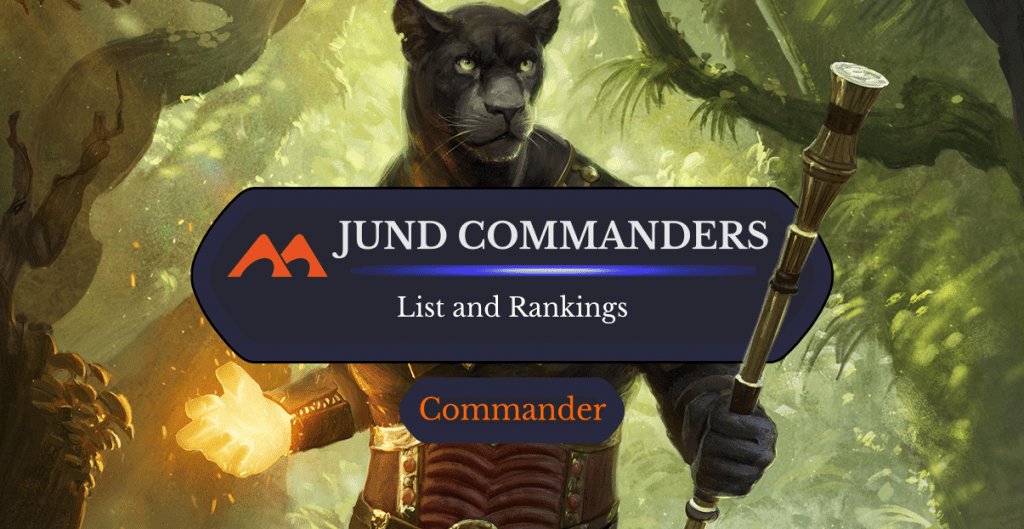
Lord Windgrace | Illustration by Bram Sels
Jund () takes the best parts of red, green, and black and mixes them together for a brutal combination of big creatures, sacrifice effects, and graveyard play. Jund decks can play like “Gruul () plus black,” “Rakdos () plus green,” and “Golgari () plus red” all at the same time.
The number of Jund commanders continues to swell with seemingly every set. That means it's just about time for a refreshed ranking of the best Jund Commanders. Which ones will top the charts? Let’s find out!
Why Go With a Jund Commander?
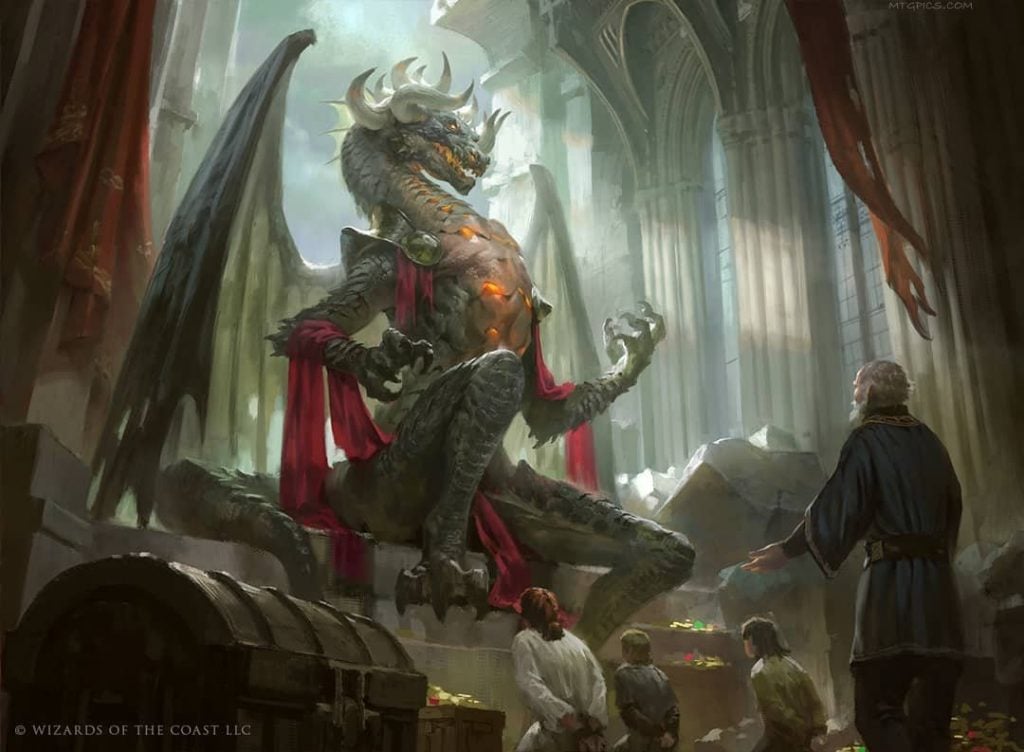
Korvold, Fae-Cursed King | Illustration by Wisnu Tan
Jund is all about permanents and punishment. Jund combines the aggression of red and green decks with the oppression of black decks to start damaging your opponents early and often. You’ll love playing Jund if you love sacrificing permanents, forcing your opponents to sacrifice permanents, and swinging in for huge damage with demons, dragons, and whatever else.
#32. Adun Oakenshield
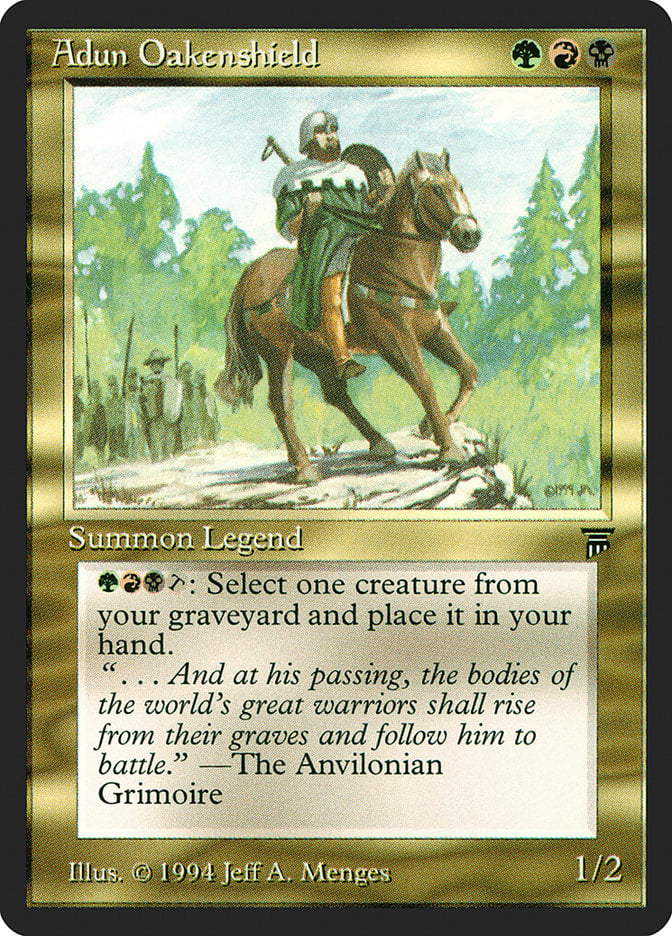
As one of the first ever Jund cards (nevermind one of the first Jund legends), Adun Oakenshield is incredibly expensive for such a mechanically boring card. This Legends legend is a cheap 1/2 creature with an activated Disentomb effect that costs 3 mana. While Jund decks typically have a lot of graveyard play, this is a 6-mana investment for an ability that’s worth one.
This is great for collectors and the odd Vorthos in your group, but it's not recommended for its power.
#31. Bartel Runeaxe
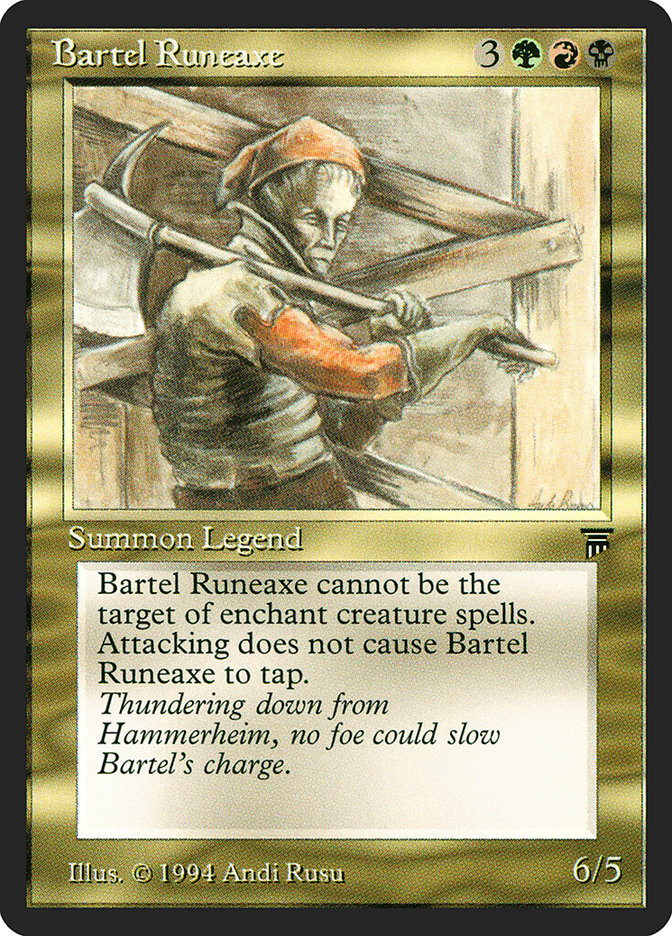
Bartel Runeaxe is the other Jund Legends legend. It’s just about as underwhelming as Adun Oakenshield, but it scores extra points for having off-color vigilance and… shroud from auras?
Bartel is a weird card, but not as unplayable as Adun.
#30. Vaevictis Asmadi
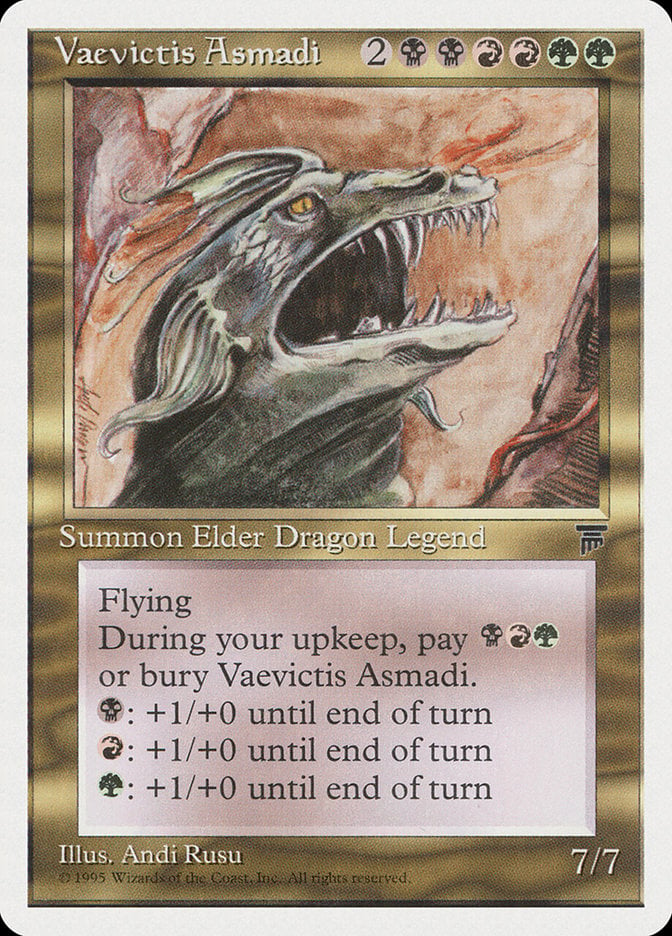
Vaevictis Asmadi, the original Jund Elder Dragon from Legends, isn’t nearly as threatening anymore as it once was. The trade off for an 8-mana casting value and a 3-mana upkeep, on top of an ability that wants you to spend as much mana as possible, just doesn’t cut it anymore.
On a mere 7/7 flying body, the original Vaevictus isn’t even guaranteed to trample past those 2/2 Drake tokens. It’ll also probably die to Murder before it can even attack.
#29. Xira Arien
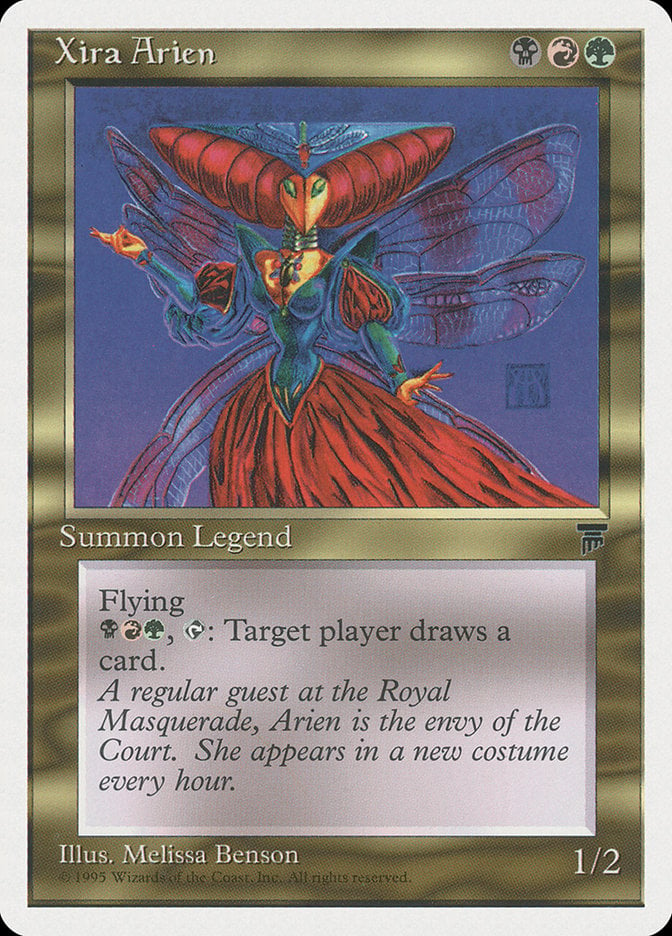
No one’s really sure what to do with Xira Arien, but that doesn’t mean it isn’t a decent commander. If you’re looking for a generic “Jund good stuff” deck, Xira Arien’s simple ability and cheap mana cost makes it an easy choice. Sure, three mana might be a little excessive to draw a card, but it’s not like we’re playing blue.
Xira makes a cute commander for an insect typal deck, but is dwarfed by its newest Dominaria United printing.
#28. Xira, the Golden Sting
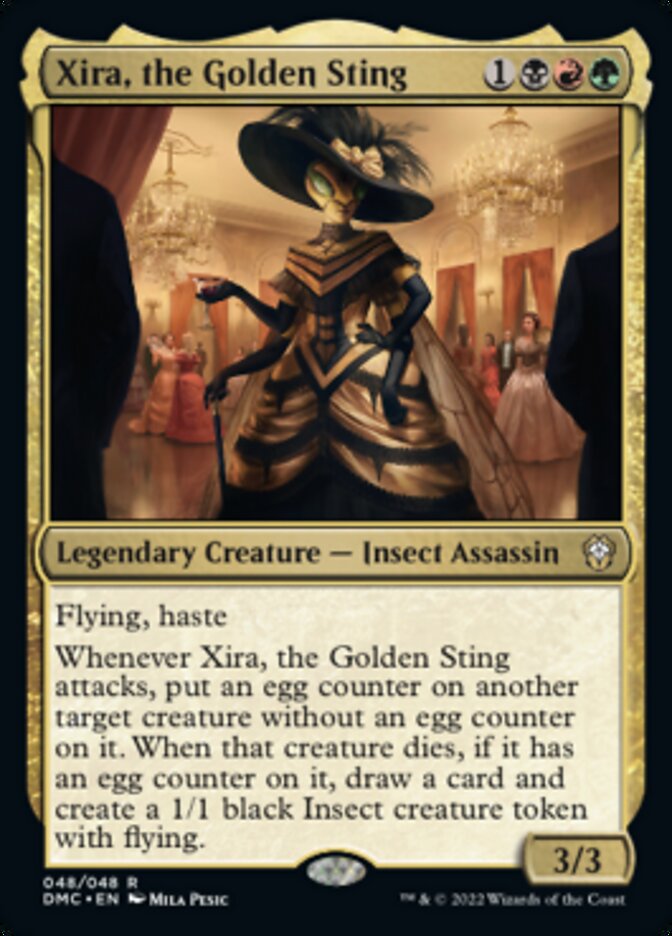
Xira, the Golden Sting is the reincarnation of original Legends creature Xira Arien. Its DMU version still draws you cards while also rewarding you for killing creatures, either your own or your opponents.
Xira’s 1/1 Insect tokens make good chump blockers, or good recipients for your egg counters. Xira decks excel at both removal and sacrifice, making it a versatile Jund commander.
#27. Darigaaz, Shivan Champion
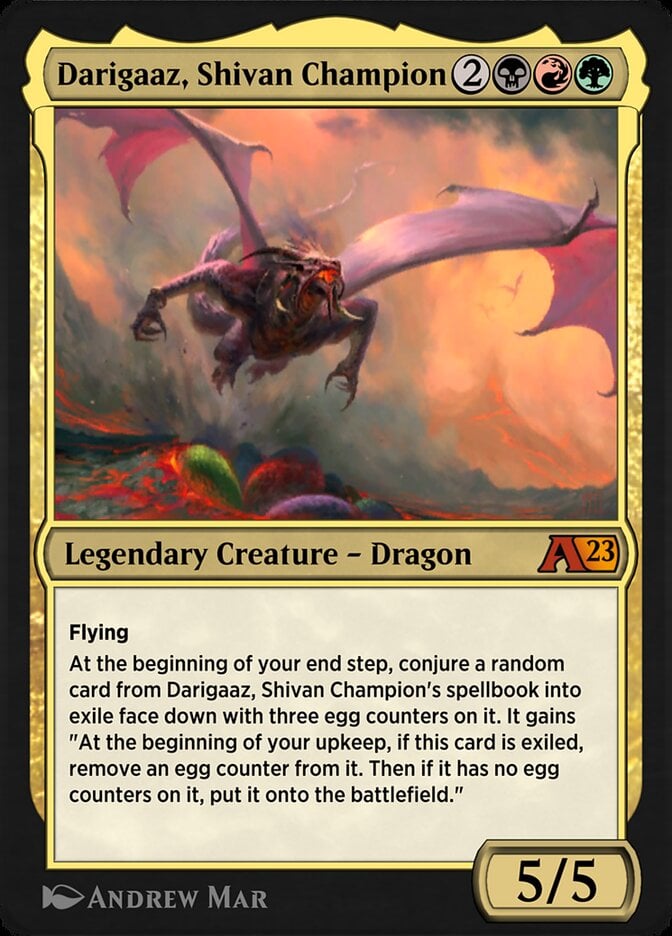
The MTG Arena-only Darigaaz, Shivan Champion is a swingy commander for Brawl decks. It’s guaranteed to get you another dragon from its spellbook, three turns from when you cast it. Assuming they don't draw immediate removal, Arena Darigaaz has the possibility to send you over the edge in terms of threats, but I wouldn’t expect any player to let it hang out longer than a turn. And even then, you’ll have three turns of treading water until your conjured dragon can hit the field, and it might not even be the dragon you’re hoping for.
#26. The Beamtown Bullies
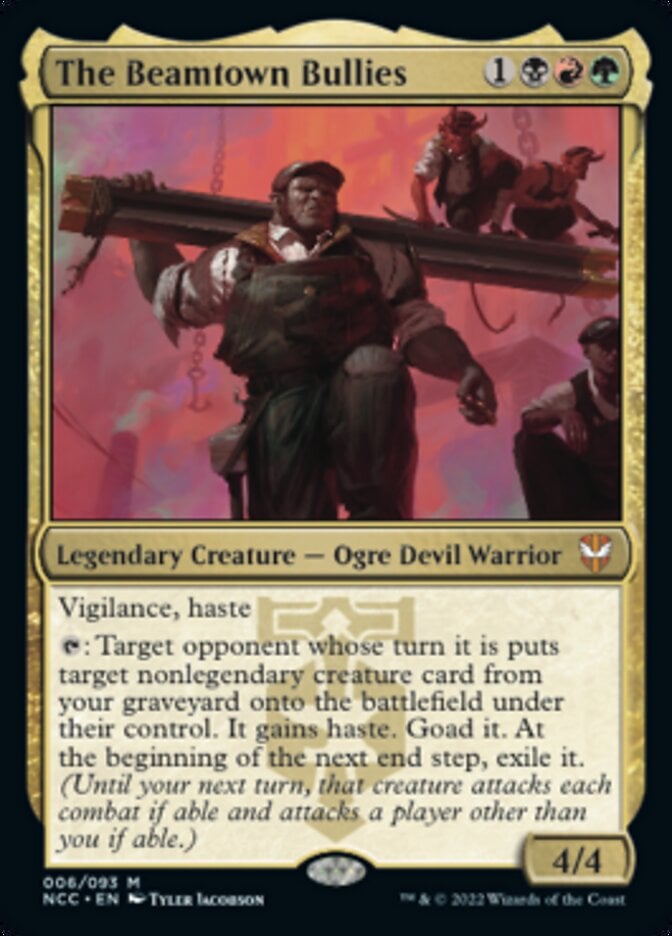
The Beamtown Bullies probably isn't the strongest Jund commander, but it's undoubtedly one of the most fun to play. Loot and mill your way to a full graveyard, and then pass some big creatures to your opponents and watch them slug each other into submission.
Play some subtle politics at the table and you’ll wind up staring down a single ragged player at the end of the game. Play the Bullies alongside detrimental attack triggers like Ebonblade Reaper to really punish your opponents.
#25. Mr. Orfeo, the Boulder

Mr. Orfeo, the Boulder is the Timmy-est of Timmy cards. Mr. Orfeo wants you to play big creatures, turn them sideways, then attack and make them even bigger. It’s a simple strategy for the simple legend, but that doesn’t mean it’s a bad one.
Slap some “damage to a player”-matters cards like The Reaver Cleaver or double down on dealing all that excess damage with Toralf, God of Fury and get to slammin’!
#24. Henzie “Toolbox” Torre
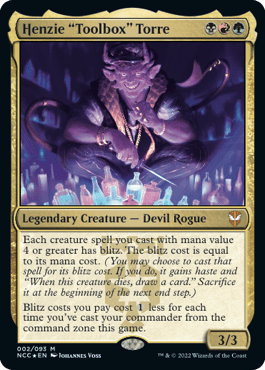
Blitz is a mechanic introduced in Streets of New Capenna, and Henzie “Toolbox” Torre was released as one of the Jund precon commanders (Riveteers Rampage). Henzie’s ability lets you blitz your medium-to-large-sized creatures into play for cheap and digs into your library when they die.
The mana reduction is directly correlated to the number of times you’ve cast Henzie from your command zone, though, meaning you’ll be pay more in commander tax than you’ll save on average after Henzie has inevitably been removed a few times.
#23. Bhaal, Lord of Murder
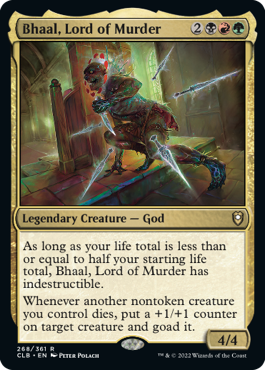
Bhaal, Lord of Murder is one of the legendary gods from the Forgotten Realms setting. As its name implies, it deals with death and dying to goad creatures in Commander games to force your opponents to deal damage to each other, or else lose their essential creatures in combat. Its 4/4 body isn’t anything to write home about, but at least it becomes indestructible when you reach half of your starting health.
Similar to Sek'Kuar, Deathkeeper, Bhaal requires nontoken fodder to trigger its abilities, so things like Endless Cockroaches and Bloodsoaked Champion make great additions to a Bhaal deck.
#22. Vazi, Keen Negotiator
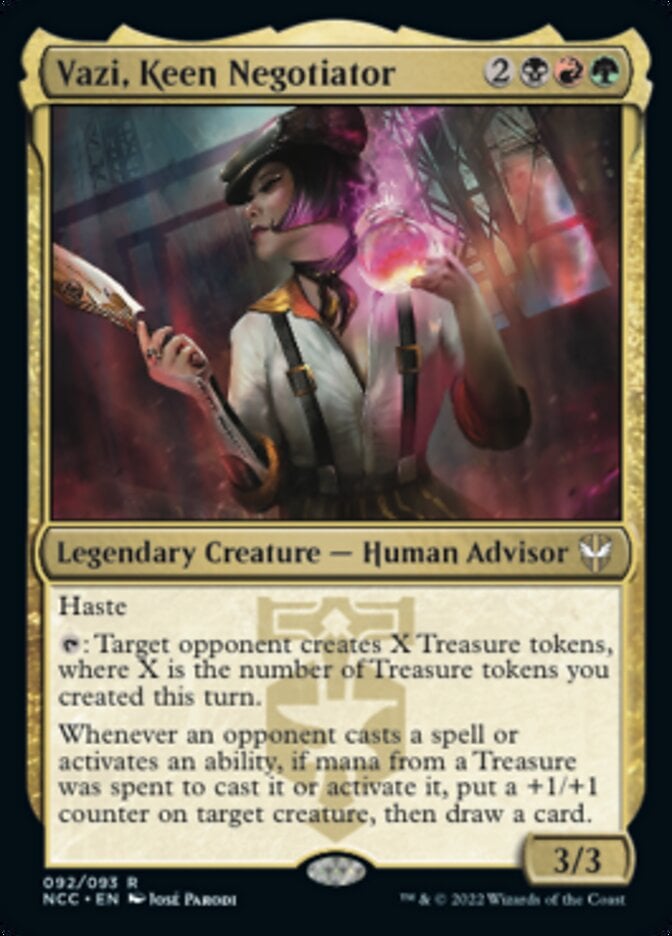
Treasure tokens really took off in Streets of New Capenna, and Vazi, Keen Negotiator uses those tokens to bribe its way to victory. As long as you can create Treasure you can share that wealth with an opponent, knowing you’ll get the upper hand after the fact when you buff your creatures and start drawing cards.
Treasure tokens have become so ubiquitous to Commander games that Vazi doesn’t even need to give new tokens to opponents with all the Revel in Riches and Big Scores going around.
#21. Darigaaz, the Igniter
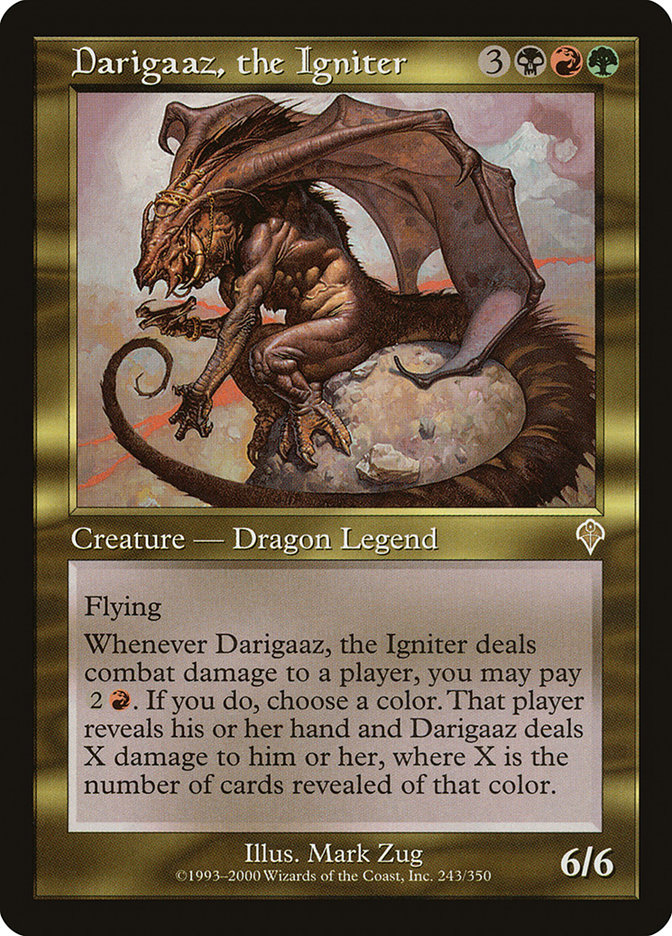
Darigaaz, the Igniter is the Jund installment of the original cycle of Primeval dragons from Invasion. Like its kin, the Igniter has a triggered ability that prompts you to pay mana to activate it (I know, it’s needlessly confusing). Darigaaz plays a fun mind-game with your opponent where you choose a color and deal extra damage based on the number of cards of that color in their hand.
This is a swingy ability, overperforming against monocolor decks and potentially whiffing against anything with three or more colors. Without access to blue and Telepathy effects, Darigaaz decks have to rely on black’s discard effects to check their opponents’ hands before dealing damage. Unfortunately this is a lot of set up for very little payoff. You’re looking at 9 mana just for Darigaaz, the Igniter plus its ability, nevermind the Duress and Swiftfoot Boots you’re running alongside it.
#20. Wasitora, Nekoru Queen
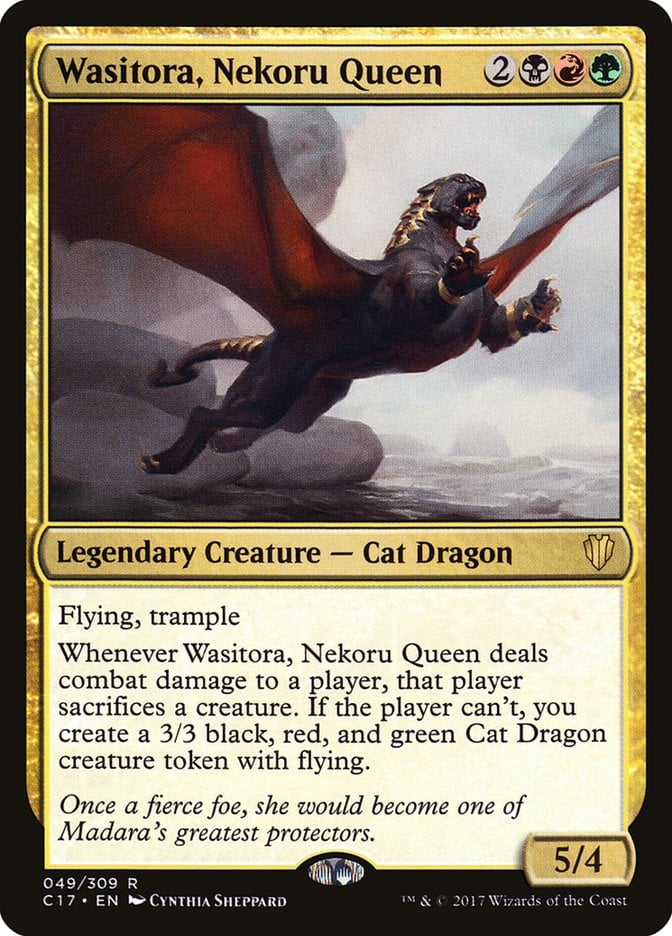
Wasitora, Nekoru Queen is the source of the illusive and painfully cute Cat Dragon token. As a 5/4 with flying and trample, it's got a good chance of connecting with an opponent and activating its effect.
Wasitora is best in a multiplayer game where you have a choice between attacking the player with creatures or without. The only criticism I have is that Wasitora should either force two sacrifices, or create two Cat Dragons. One per turn won’t keep pace with a typical Commander pod these days.
#19. Darigaaz Reincarnated
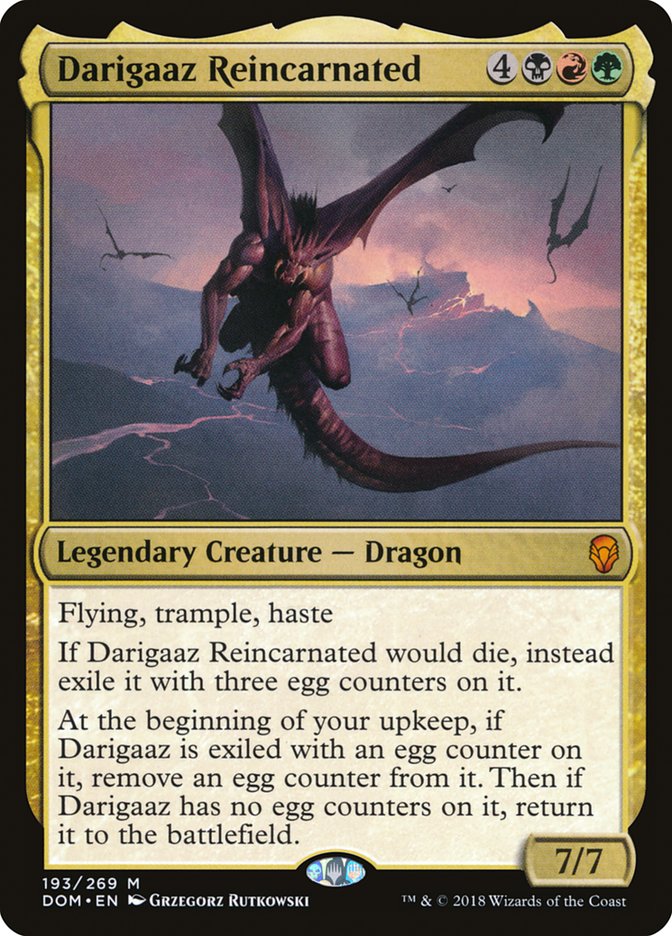
Darigaaz Reincarnated is, at face value, a 7/7 with flying, trample, and haste, which is pretty nasty in its own right. Its triggered ability is one of the only uses of the “egg counter” in Magic, which tick down in a similar way to a suspended spell until Darigaaz hatches and returns to the battlefield.
As far as I can tell there aren’t any ways to cheat and remove some of these counters early, so Darigaaz boils down to a big beater that you won’t have to pay for again.
#18. Maarika, Brutal Gladiator
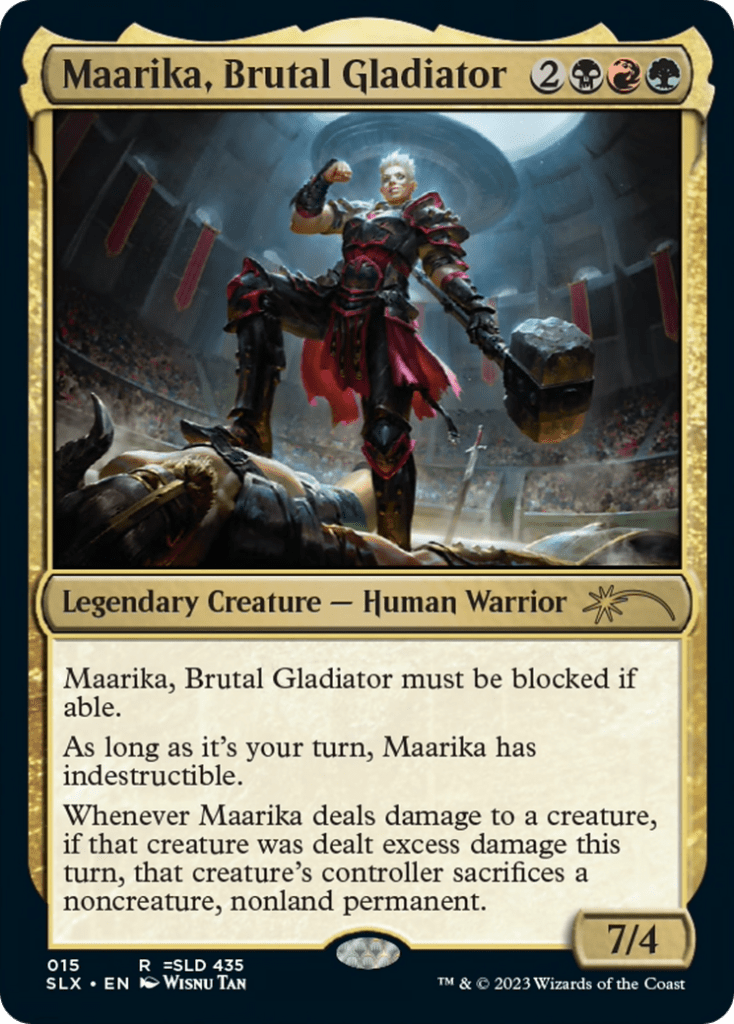
Maarika, Brutal Gladiator is the Universes Within version of Zangief, the Red Cyclone from Secret Lair x Street Fighter drop. Maarika is all about dealing more than enough damage to creatures.
This mechanic is a new design space for Magic in recent years, and I’m all for it. It slots effortlessly into Jund decks, which were often already going for an overkill scenario anyways. Maarika’s biggest demerit is the limit to one noncreature, nonland permanent per damaging attack. A single limited edict effect just can’t compare to things like Vaevictis Asmadi, the Dire’s removal, or the Shattergang Brothers’ specificity.
#17. Karrthus, Tyrant of Jund
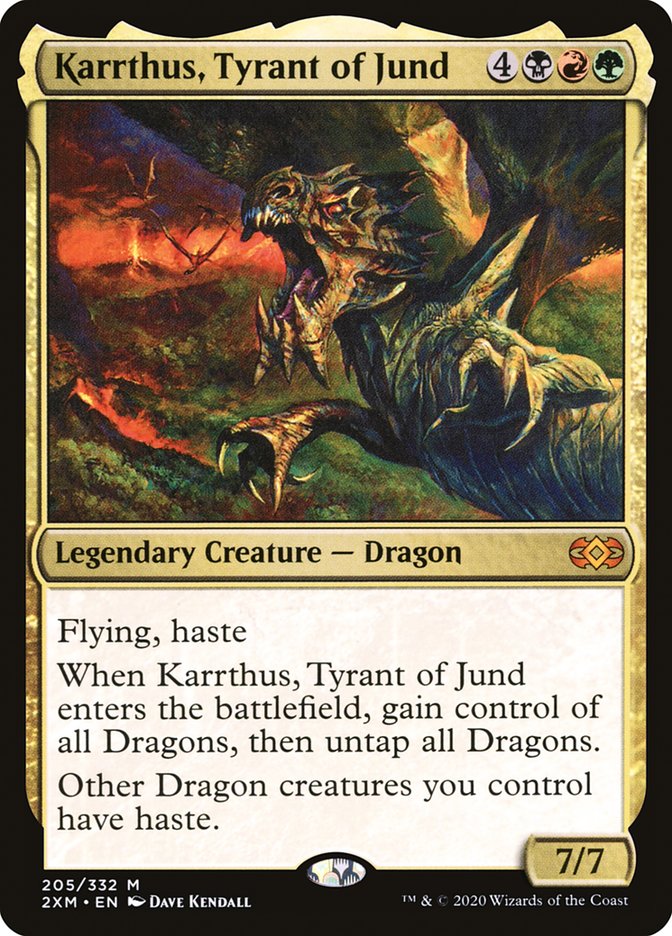
I keep swinging back and forth on whether Karrthus, Tyrant of Jund is the best dragon commander, or just entirely too situational. While some of the most powerful and popular dragons creatures are staples in EDH, Karrthus’s ETB effect isn’t guaranteed to pop off against that Karumonix, the Rat King deck. The chances you steal an opponent’s dragon that you don’t already have in your deck are slim.
Despite all that, Karrthus, Tyrant of Jund is still a 7/7 flying hasted dragon that gives the rest of your dragons haste as well. This leads to explosive turns when you surprise your pod with Hellkite Charger and Old Gnawbone or Ancient Copper Dragon, one of my favorite ways to get infinite combat steps.
#16. Soul of Windgrace
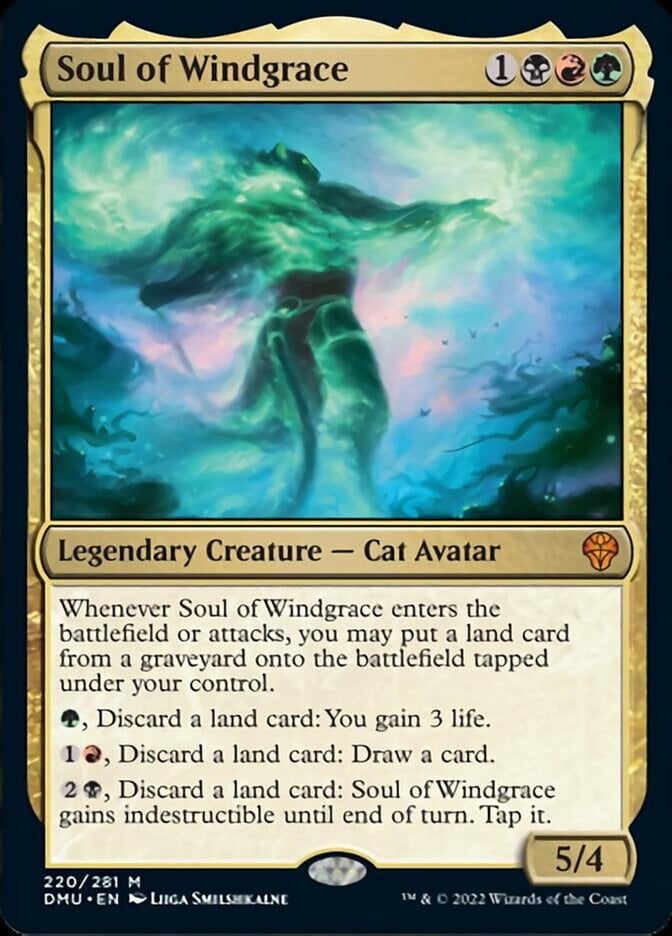
The ephemeral form of Lord Windgrace returned in Dominaria United’s Soul of Windgrace. This 4-mana 5/4 is chock full of value, guaranteed to pull a land out of your graveyard every turn starting when it hits the field. You’re guaranteed to have a land in your grave, too, since its three activated abilities each require you to discard one.
Luckily, Soul of Windgrace’s abilities lend it towards attacking every turn and activating one of those abilities each time, either saving itself from destruction or generating a small amount of advantage.
#15. Thantis, the Warweaver
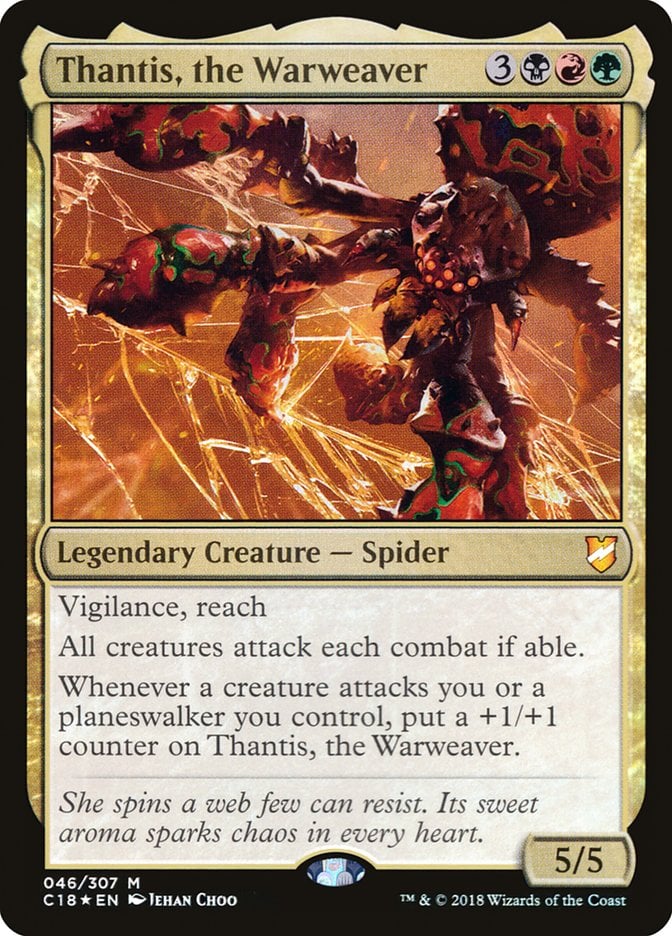
For all you creepy-crawly fans out there, Thantis, the Warweaver is here for you. Thantis is the only legendary spider with red in its color identity, giving you access to the Gruul staple Dragonlair Spider.
Thantis also plays a fun politics game. Goading opponents’ creatures in multiplayer games forces them to swing into detrimental situations. Once they’re out of other options, they’ll break themselves on your impenetrable wall of reaching–deathtouching spiders.
#14. Slimefoot and Squee
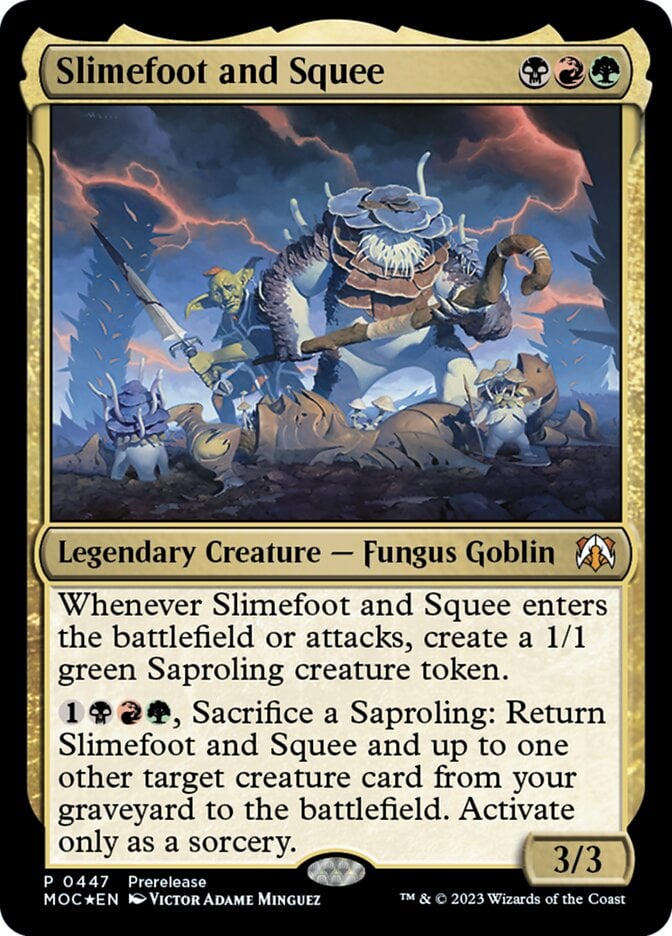
Slimefoot, the fungus-y thallid thing, and Squee, the luckiest goblin in the multiverse, team up in March of the Machine’s Commander decks as Slimefoot and Squee. Together they’re a 3/3 creature for three mana that creates Saproling tokens to use later on with its activated ability. Slimefoot and Squee is unique in that it's one of the only commanders you actually want to go to the graveyard rather than the command zone.
Reminiscent of Derevi, Empyrial Tactician, Slimefoot and Squee has a tricky way to get around the commander tax it’d usually suffer after the first time it dies. Absent any graveyard removal, you’ll never pay more than four mana for your commander, plus another creature of your choice. Jund has access to mill and discard effects too, easily seeding the graveyard with juicy reanimator targets.
#13. Ognis, the Dragon’s Lash
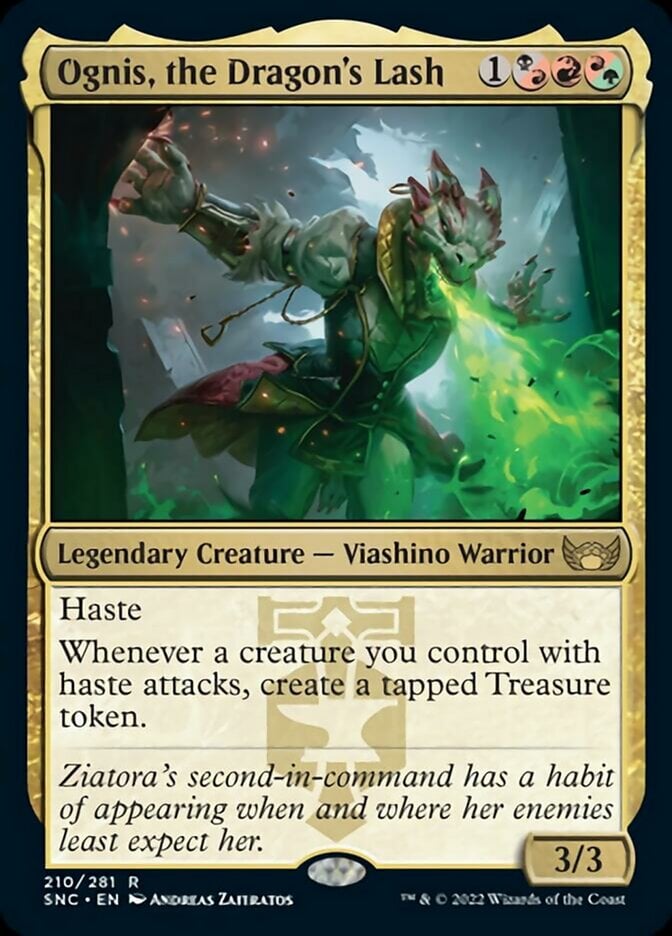
Do you have a taste for haste? Ognis, the Dragon's Lash is for you.
Two hybrid mana symbols make Ognis easy to cast, and you’ll want to turn both Ognis and every creature you play sideways as soon as possible to start stacking up those Treasure tokens. Grab Fervor or Rhythm of the Wild and get that Treasure token from every creature in your library.
Ognis also makes a great commander for a Viashino deck if you’re ever looking for a weird creature type to focus on.
#12. Kresh the Bloodbraided
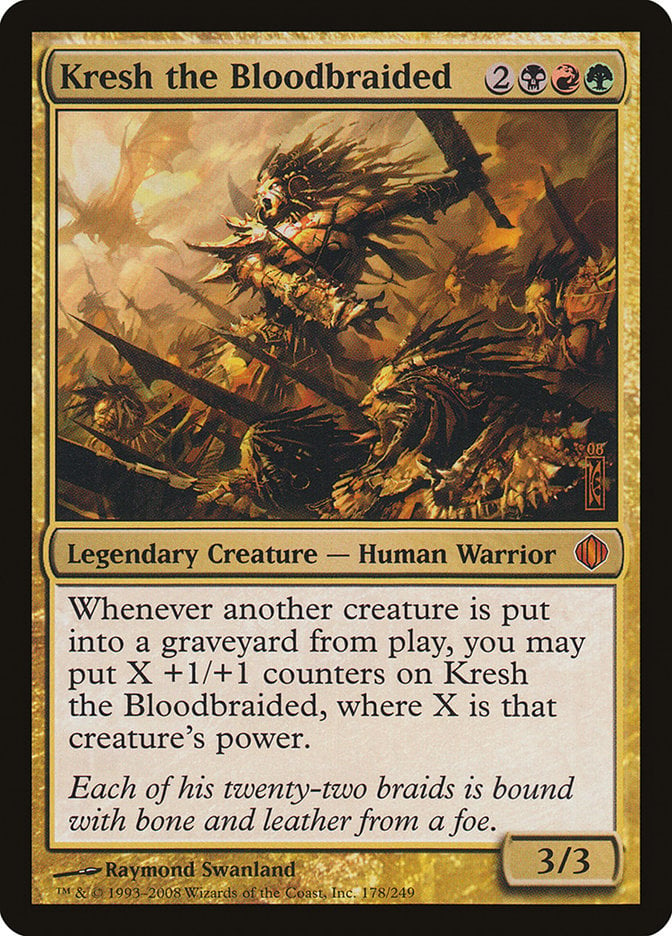
Five mana for the 3/3 Kresh the Bloodbraided seems like a bad deal, until you consider its inverse-Hamletback Goliath effect. There are a few ways to take advantage of this to start pumping Kresh up early.
Ball Lightnings and other high-power creatures that die at the end of the turn turn that extra power right into +1/+1 counters for Kresh, and Rite of the Raging Storm will give you a free death trigger on each of your opponents’ turns. Toss in some evoke creatures in lieu of regular removal and interaction, and Kresh is looking pretty beefy, ready to Fling itself at an opponent.
#11. Korvold, Gleeful Glutton
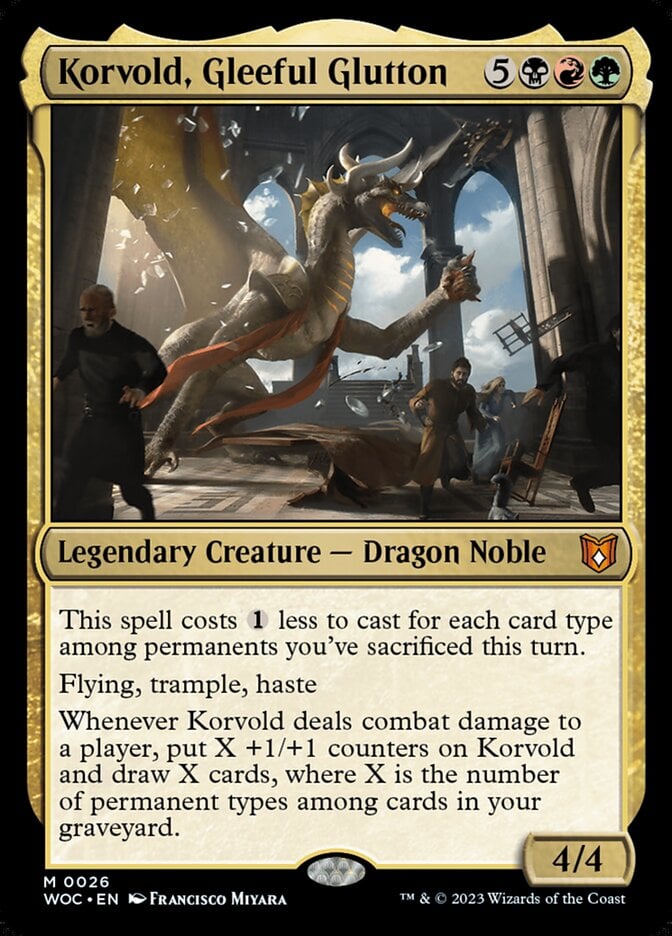
The polls are in, Jund players love Korvold. They can’t get enough of this greedy little dragon. Wilds of Eldraine saw their return as Korvold, Gleeful Glutton, a new incarnation that costs almost twice as much mana to cast. However, its cost-reduction ability can mitigate that, and it’ll grow exponentially compared to Korvold, Fae-Cursed King.
Old Korvold still reigns supreme in my mind – by simple virtue of hitting the field and dealing damage so early – but Gleeful Glutton still has a place in the Jund ladder. Gleeful Glutton will probably outlast original Korvold in any Commander game that goes long. No doubt drawing heavy fire from targeted removal, Korvold, Gleeful Glutton’s cost reduction will keep it returning to the field by skipping that commander tax you’ll have to pay for Korvold, Fae-Cursed King. Of course, you could just win before the game starts to go long, instead.
#10. Indoraptor, the Perfect Hybrid
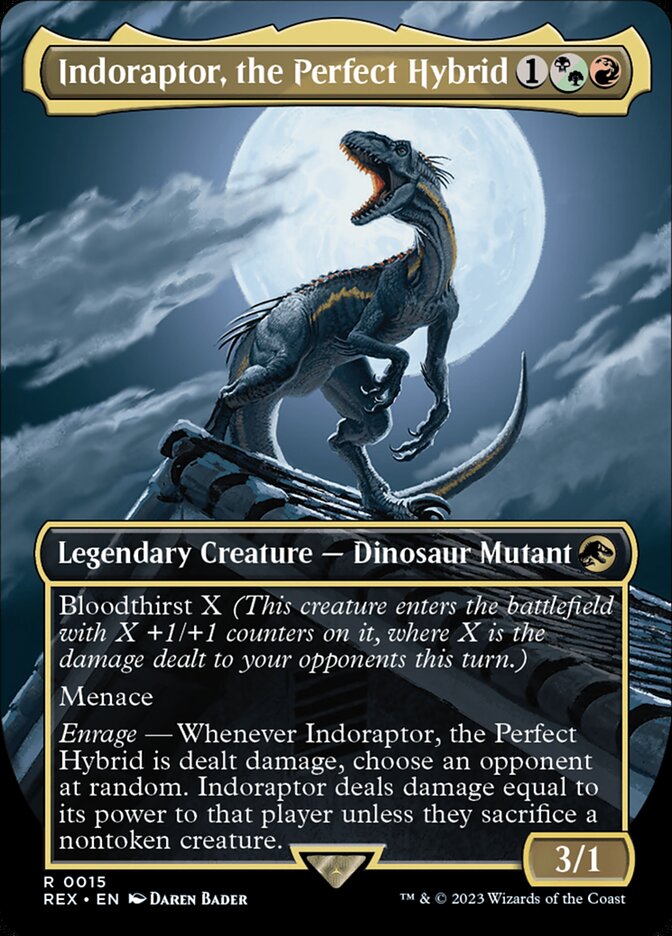
Indoraptor, the Perfect Hybrid comes from the Jurassic World Collection, a selection of Jurassic Park themed cards distributed alongside The Lost Caverns of Ixalan. Indoraptor combines two damage-based mechanics on a single card in a way we’ve never seen before. This commander screams “group slug” to me, making the perfect leader for a deck running a ton of “hurts everybody” effects like Sulfuric Vortex, and its color identity means you get access to both Pestilence and Pyrohemia to damage your opponents and trigger enrage simultaneously. Indoraptor is the new kid on the block, but I’m expecting it to perform very well once it’s settled into the Jund ring.
#9. Shattergang Brothers
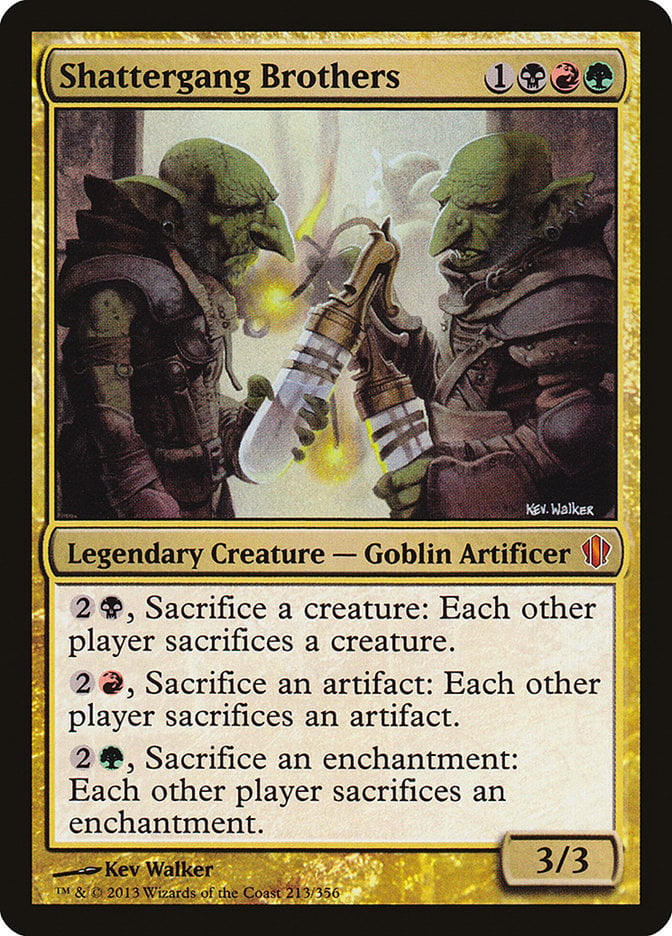
The Super Shattergang Brothers are the Jund commander for the control player. Keep a wide array of permanents on the field and keep your opponents’ boards small by removing their permanents before they can use them.
Double up on those edicts with Butcher of Malakir and Dictate of Erebos, and return your permanents with Timeless Witness-style effects.
#8. Yurlok of Scorch Thrash
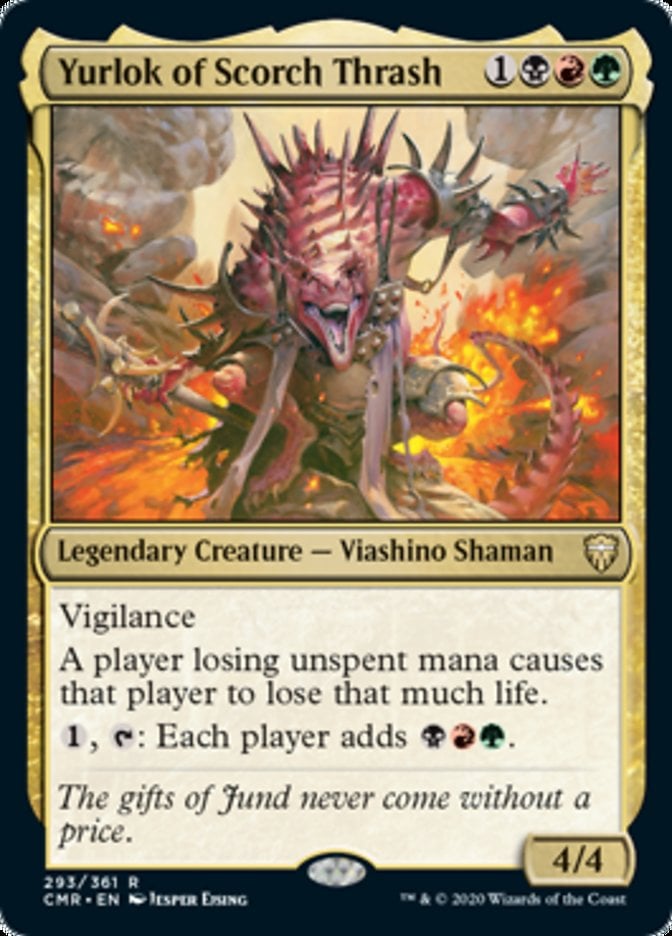
Remember mana burn? Probably not! Yurlok of Scorch Thrash brings the old concept of mana burn back into Commander by turning their unspent mana into lost life.
Yurlok makes a great group slug commander, and many run it as the leader of a deck stuffed with Manabarbs, Citadel of Pain, and War's Toll. You’re playing a dangerous game with Yurlok; you’ll often want to give your opponents extra mana to waste using Gauntlet of Power or Zhur-Taa Ancient, but you run the risk of ramping them into their biggest spells.
All in all, Yurlok of Scorch Thrash plays a unique strategy in Jund decks and shouldn’t be counted out.
#7. Sek’Kuar, Deathkeeper
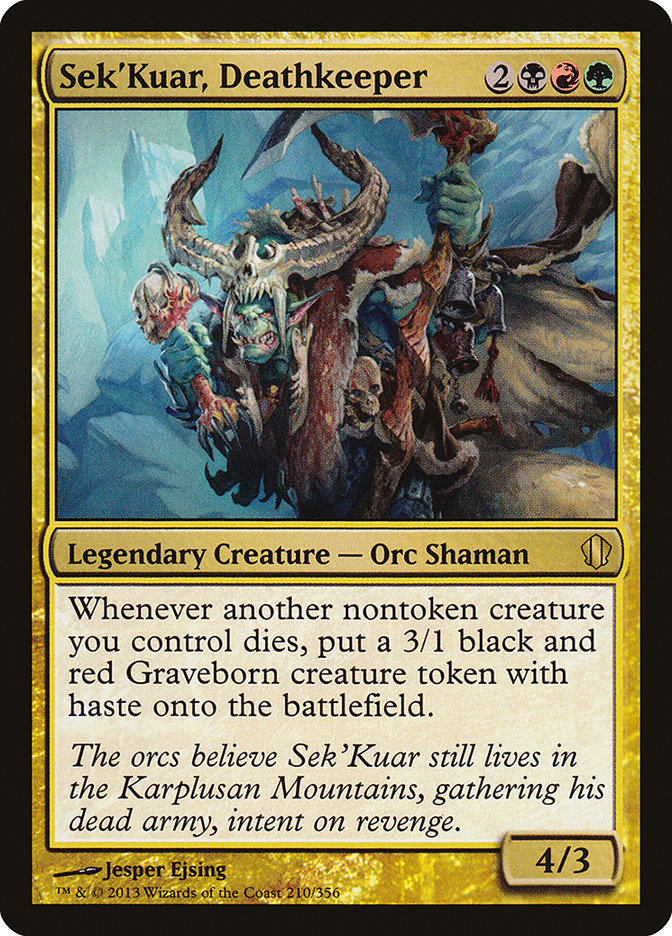
Commander 2013 was my introduction to the format, so maybe I have a soft spot for Sek'Kuar, Deathkeeper.
But my affection isn’t wholly unearned as Sek’Kuar has an exciting build-around ability I’ve had a lot of fun playing with over the past decade. The restrictions on nontoken creatures means you can’t abuse any of those Saproling–aristocrats builds you see in Ghave, Guru of Spores, and the hasted Graveborn tokens are most valuable when you create them before combat on your turn. This means Sek’Kuar plays a big Main Phase game, usually bouncing one creature to and from the battlefield multiple times in a single turn.
I like using Tymaret, the Murder King for this, but any ol’ Reassembling Skeleton will do.
#6. Gyrus, Waker of Corpses
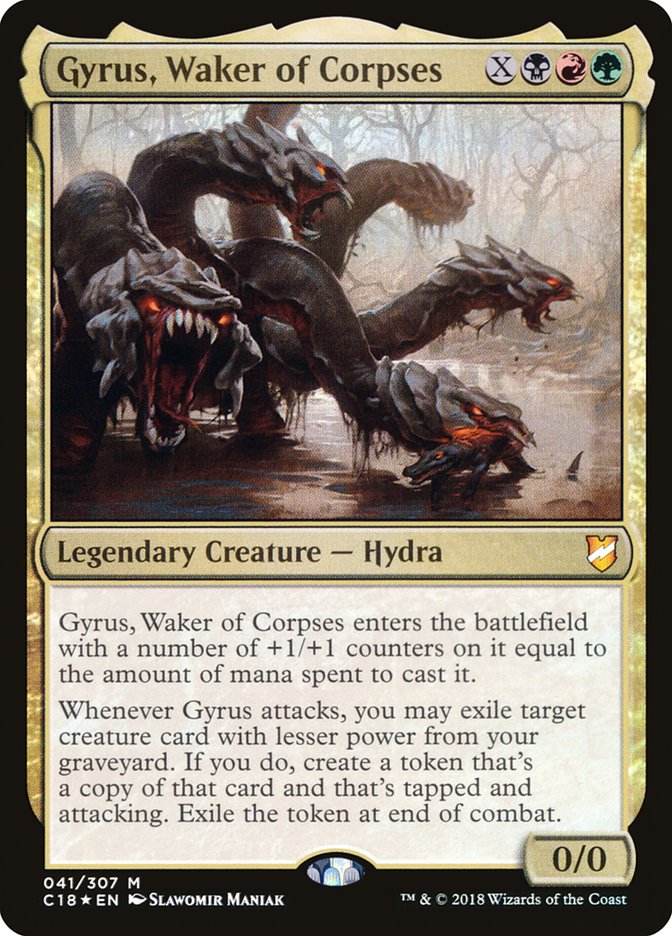
Gyrus, Waker of Corpses is Commander 2018’s premier hydra and reanimator commander.
I like to think of Gyrus as a Jund version of Alesha, Who Smiles at Death. While Gyrus is heavily reliant on how much mana you can cast it for, both decks create a toolbox of creatures in your graveyard, and release them one (or two with a Strionic Resonator) at a time to respond to threats. Soon you’ll be reanimating your own threat like Bladewing, Deathless Tyrant, or sneaking a Master of Cruelties into a player with no blockers.
Buried Alive is the best starting point for a deck like Gyrus. Need noncreature removal? Bury Bane of Progress or Acidic Slime, depending on Gyrus’s power. Got Gyrus up to a billion +1/+1 counters but need a board wipe? Dig up Massacre Wurm. Just looking to fill up the graveyard again? Unearth Vile Entomber.
#5. Vaevictis Asmadi, the Dire
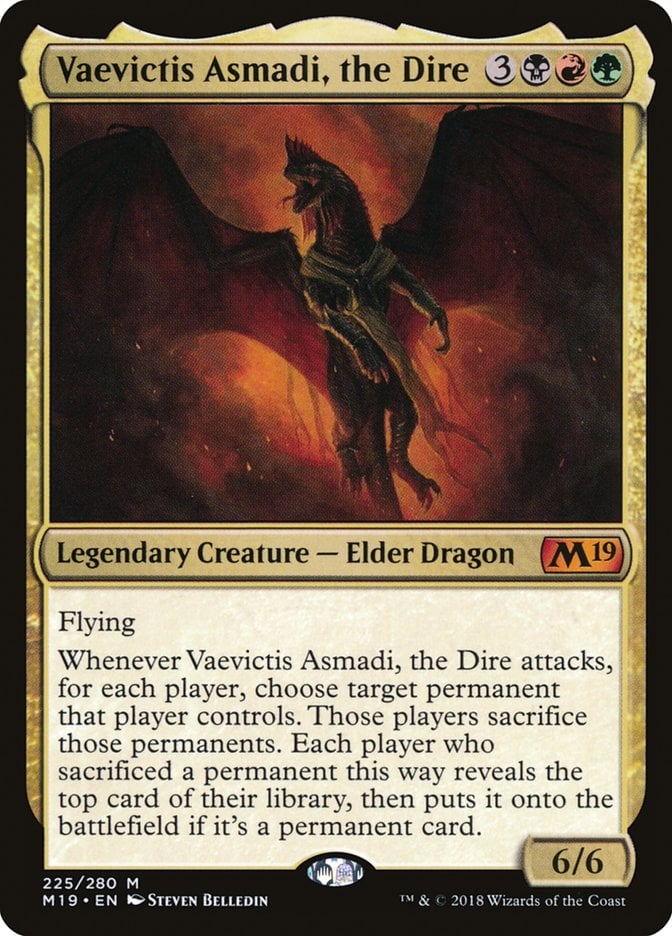
Vaevictis Asmadi, the Dire has a built-in sacrifice-Chaos Warp that hits every player whenever it attacks. With some top-deck manipulation and a heavy reliance on permanents, you can use this to much greater advantage than your opponents by removing their key pieces from the board and digging for your valuable wincons.
Vaevictis is often see at the helm of Primal Surge “oops-all-permanents” decks where you’re guaranteed to never whiff on the top deck.
#4. Lord Windgrace

Lord Windgrace is the only Jund planeswalker that can be your commander, and it has some very unique loyalty abilities to show for it.
For a long time Lord Windgrace was the go-to for land destruction/sacrifice decks on account of its easy access to land recursion and a beneficial effect that puts them there. Windgrace decks give you access to all the typical lands-in-graveyard cards like The Gitrog Monster and Titania, Protector of Argoth, and with the addition of red you can use sleepers like Aggressive Mining, Tectonic Reformation, and Seismic Assault to churn out advantage. Obviously Wrenn and Six make a great addition to this deck, too.
Lord Windgrace’s final loyalty ability is a flavor hit despite its steep activation cost. It reads like two Violent Ultimatums and a host of tokens reminiscent of Jedit Ojanen of Efrava. While not a game-ender in its own right, it gives you control of the board while removing any pertinent threats.
#3. Ziatora, the Incinerator
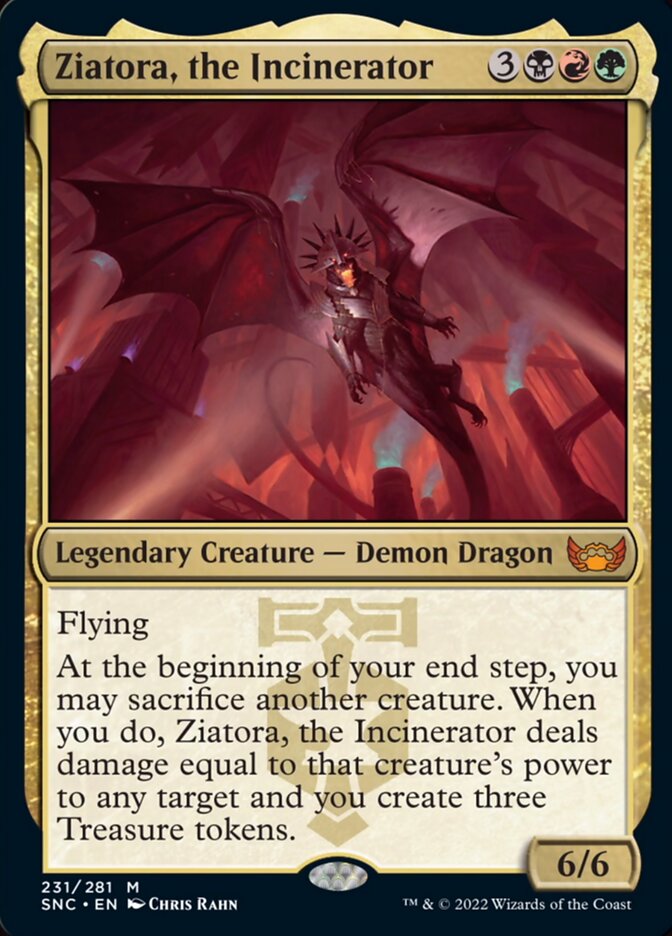
For fans of Fling there’s Ziatora, the Incinerator, a Jund dragon with a triggered Fling effect at each of your end steps. It’s for players who like big creatures dealing big damage and dying only to return them to the battlefield again.
Ziatora loves a Butcher of Malakir or Dictate of Erebos and, appropriately, becomes very powerful with Riveteers Ascendancy or Mr. Orfeo, the Boulder in play. All this and we haven’t even touched on those three Treasure tokens you get each time you sacrifice a creature!
I see Ziatora, the Incinerator as sort of a midground between Korvold and Prossh. It doesn’t need the combat step to deal damage, and its ability triggers the turn it comes in. Ziatora ramps you, but Korvold draws cards and Prossh makes its own sacrificial fodder.
#2. Prossh, Skyraider of Kher
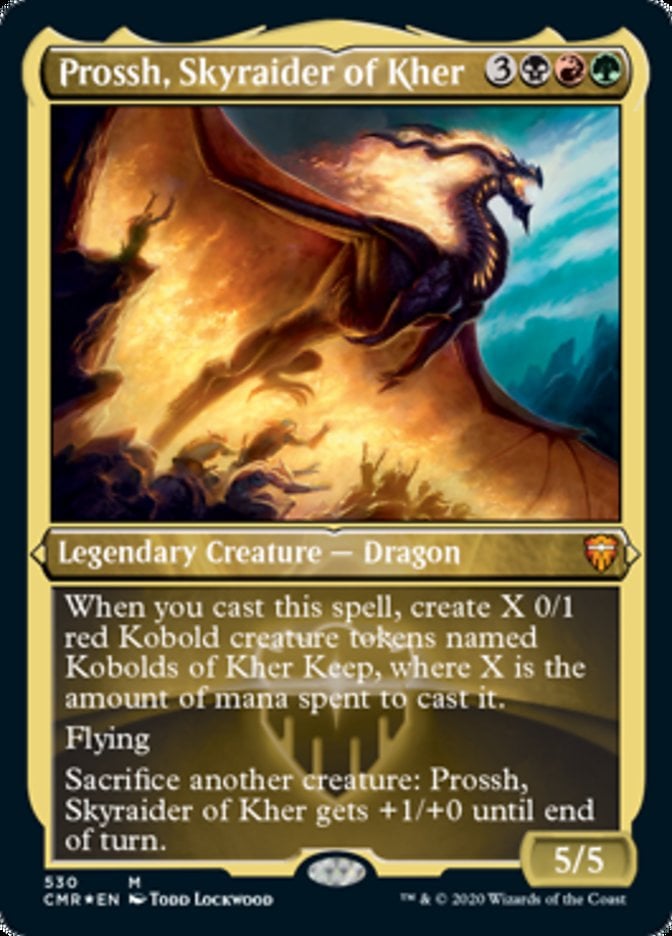
Prossh, Skyraider of Kher is the OG Jund commander. It’s the face-card for Commander 2013’s Power Hungry deck, and it has earned that spot time and again.
Prossh is the best of the cycle of “commander tax matters” legends from Commander 2013, and it’s not even close. Those effects are mostly misses since no one wants to rely on paying more and more for their commander as a strategy. Luckily, you only need to cast Prossh once to win.
Prossh’ll bring six 0/1 Kobolds into play when it first hits the field. Assuming you do a little bit of setup (easily achieved with access to green’s ramp and black’s tutors), you can have some protection ready with Swiftfoot Boots, some Impact Tremors-like effects, and some sacrifice synergies like Blood Artist and Mayhem Devil to maximize the damage those Kobolds deal on the way in and on the way out.
Prossh is typically the final play in its deck, after you’ve filled your board with the aforementioned damagers and a Parallel Lives or Dictate of Erebos to boot. Once you can swing with Prossh you’ll sacrifice your entire board to buff its power to finish off damaged players.
#1. Korvold, Fae-Cursed King
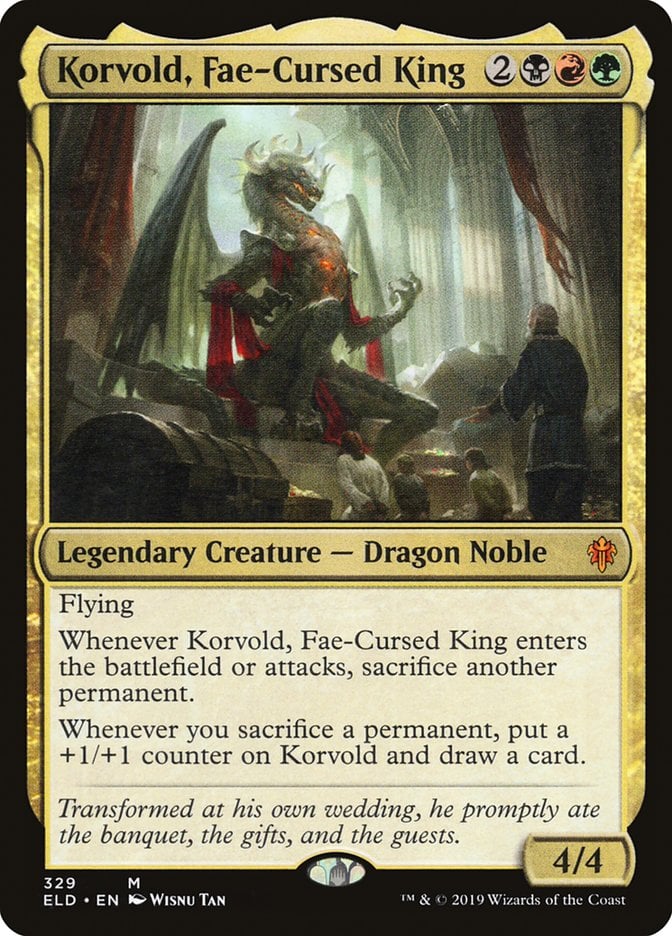
Korvold, Fae-Cursed King is one of those cards where the rules text reads like poetry. Korvold’s triggered abilities play so well with each other and synergize with just about any sacrifice ability you could wish for.
Since Korvold doesn’t specify that the permanents need be nontokens it loves Clues, Treasures, and any of your expendable creature tokens. It refills your hand as it gets permanently bigger, and it costs one less to cast than Prossh, Skyraider of Kher. The value shoved into Korvold almost feels like a mistake.
Commanding Conclusion
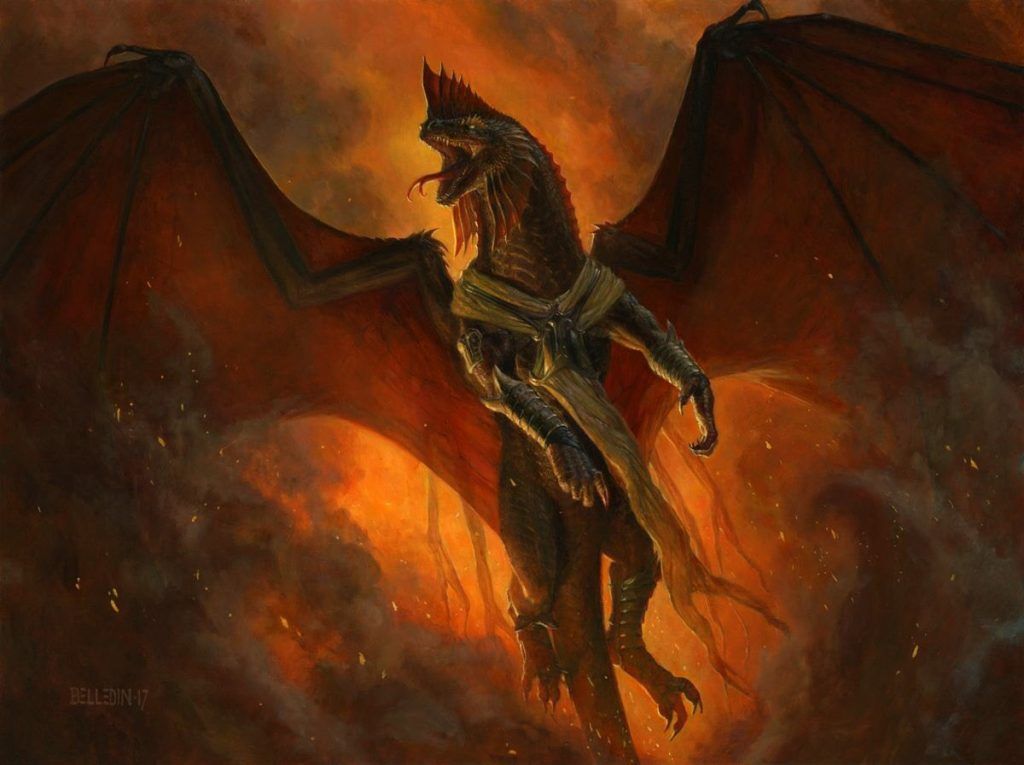
Vaevictis Asmadi, the Dire | Illustration by Steven Belledin
We’ve been playing Jund decks in Commander since its inception, and Jund has always had a strong “feel” for what it’s good at and what mechanics it's allowed to have. With any of these Jund Commanders you’ll dominate the board with removal, sacrificial effects, and the biggest, baddest creatures you can conjure up.
Which Jund deck will you be building? Is Korvold, Fae-Cursed King really deserving of the #1 spot, or does Prossh, Skyraider of Kher still hold up? Let me know in the comments below, or join the discussion in Draftsim’s Discord.
Thanks for reading, until our shards collide again!
Note: this post contains affiliate links. If you use these links to make a purchase, you’ll help Draftsim continue to provide awesome free articles and apps.
Follow Draftsim for awesome articles and set updates: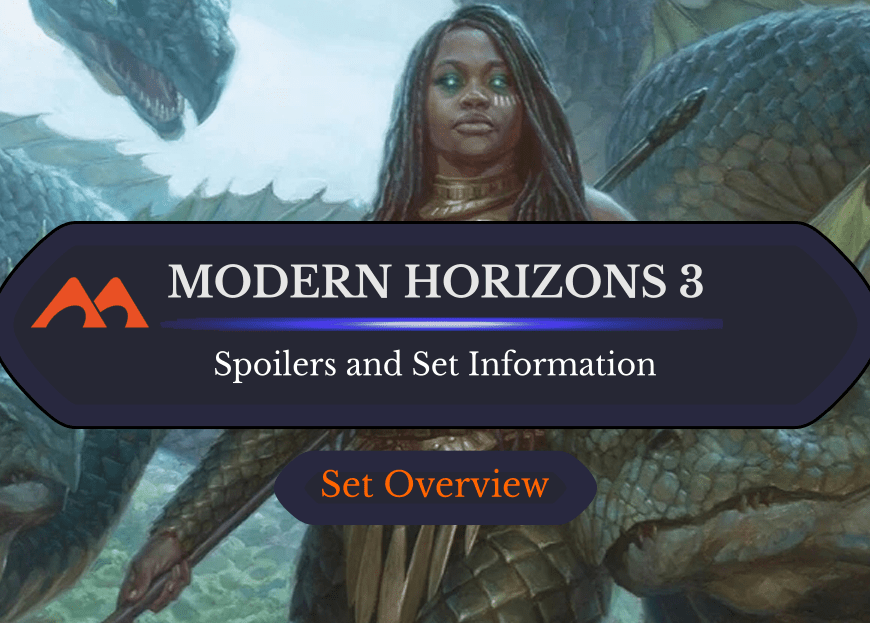
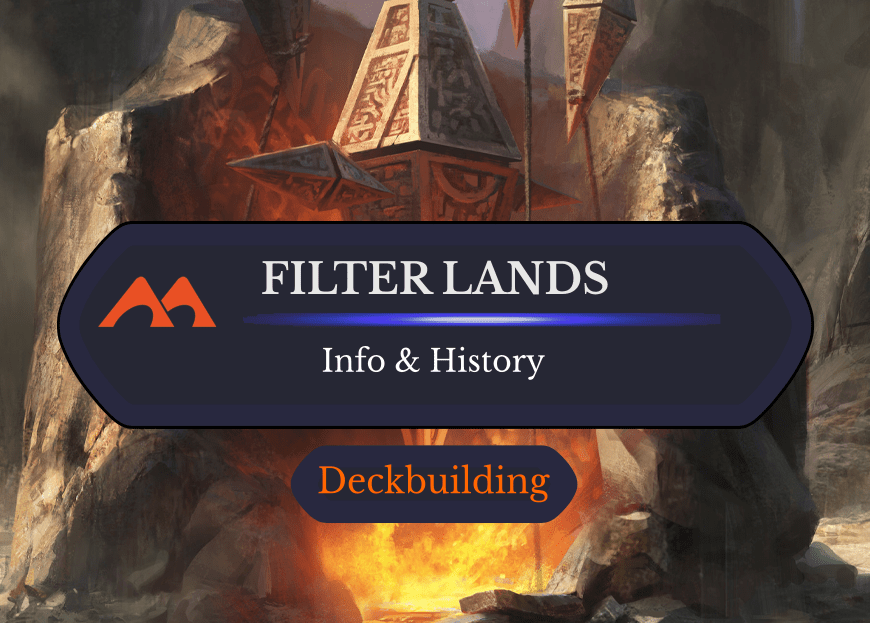
2 Comments
Not even a mention of Thantis, the Warweaver?
Hey, David,
Thanks for reading and your comment, I really appreciate it.
I chose not to include Thantis on this list for two reasons:
First is that I don’t see Thantis as a particularly strong commander. While forced combat is a unique strategy, it is pretty straightforward and doesn’t necessitate the same kind of detail a re-animator combo deck might.
Second is that Thantis is a precon commander from 2018. I don’t hold anything against the precon commanders, some are incredible. However, I think this factors in to seriously inflate the number of decks online, and make Thantis seem more popular than he really is.
Add Comment